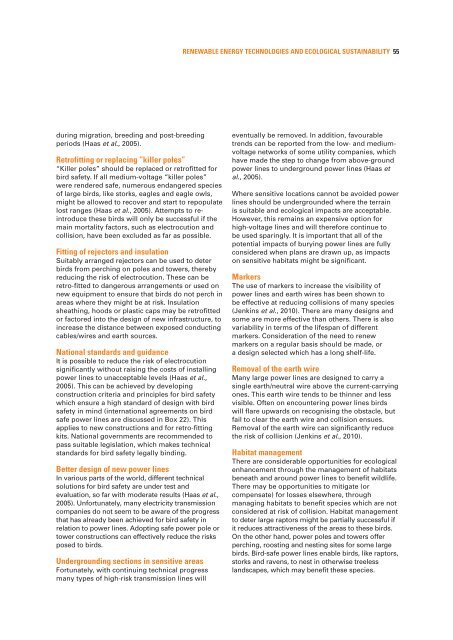Meeting Europe's renewable energy targets in harmony with - RSPB
Meeting Europe's renewable energy targets in harmony with - RSPB
Meeting Europe's renewable energy targets in harmony with - RSPB
Create successful ePaper yourself
Turn your PDF publications into a flip-book with our unique Google optimized e-Paper software.
RENEWABLE ENERGY TECHNOLOGIES AND ECOLOGICAL SUSTAINABILITY 55<br />
dur<strong>in</strong>g migration, breed<strong>in</strong>g and post-breed<strong>in</strong>g<br />
periods (Haas et al., 2005).<br />
Retrofitt<strong>in</strong>g or replac<strong>in</strong>g “killer poles”<br />
“Killer poles” should be replaced or retrofitted for<br />
bird safety. If all medium-voltage “killer poles”<br />
were rendered safe, numerous endangered species<br />
of large birds, like storks, eagles and eagle owls,<br />
might be allowed to recover and start to repopulate<br />
lost ranges (Haas et al., 2005). Attempts to re<strong>in</strong>troduce<br />
these birds will only be successful if the<br />
ma<strong>in</strong> mortality factors, such as electrocution and<br />
collision, have been excluded as far as possible.<br />
Fitt<strong>in</strong>g of rejectors and <strong>in</strong>sulation<br />
Suitably arranged rejectors can be used to deter<br />
birds from perch<strong>in</strong>g on poles and towers, thereby<br />
reduc<strong>in</strong>g the risk of electrocution. These can be<br />
retro-fitted to dangerous arrangements or used on<br />
new equipment to ensure that birds do not perch <strong>in</strong><br />
areas where they might be at risk. Insulation<br />
sheath<strong>in</strong>g, hoods or plastic caps may be retrofitted<br />
or factored <strong>in</strong>to the design of new <strong>in</strong>frastructure, to<br />
<strong>in</strong>crease the distance between exposed conduct<strong>in</strong>g<br />
cables/wires and earth sources.<br />
National standards and guidance<br />
It is possible to reduce the risk of electrocution<br />
significantly <strong>with</strong>out rais<strong>in</strong>g the costs of <strong>in</strong>stall<strong>in</strong>g<br />
power l<strong>in</strong>es to unacceptable levels (Haas et al.,<br />
2005). This can be achieved by develop<strong>in</strong>g<br />
construction criteria and pr<strong>in</strong>ciples for bird safety<br />
which ensure a high standard of design <strong>with</strong> bird<br />
safety <strong>in</strong> m<strong>in</strong>d (<strong>in</strong>ternational agreements on bird<br />
safe power l<strong>in</strong>es are discussed <strong>in</strong> Box 22). This<br />
applies to new constructions and for retro-fitt<strong>in</strong>g<br />
kits. National governments are recommended to<br />
pass suitable legislation, which makes technical<br />
standards for bird safety legally b<strong>in</strong>d<strong>in</strong>g.<br />
Better design of new power l<strong>in</strong>es<br />
In various parts of the world, different technical<br />
solutions for bird safety are under test and<br />
evaluation, so far <strong>with</strong> moderate results (Haas et al.,<br />
2005). Unfortunately, many electricity transmission<br />
companies do not seem to be aware of the progress<br />
that has already been achieved for bird safety <strong>in</strong><br />
relation to power l<strong>in</strong>es. Adopt<strong>in</strong>g safe power pole or<br />
tower constructions can effectively reduce the risks<br />
posed to birds.<br />
Underground<strong>in</strong>g sections <strong>in</strong> sensitive areas<br />
Fortunately, <strong>with</strong> cont<strong>in</strong>u<strong>in</strong>g technical progress<br />
many types of high-risk transmission l<strong>in</strong>es will<br />
eventually be removed. In addition, favourable<br />
trends can be reported from the low- and mediumvoltage<br />
networks of some utility companies, which<br />
have made the step to change from above-ground<br />
power l<strong>in</strong>es to underground power l<strong>in</strong>es (Haas et<br />
al., 2005).<br />
Where sensitive locations cannot be avoided power<br />
l<strong>in</strong>es should be undergrounded where the terra<strong>in</strong><br />
is suitable and ecological impacts are acceptable.<br />
However, this rema<strong>in</strong>s an expensive option for<br />
high-voltage l<strong>in</strong>es and will therefore cont<strong>in</strong>ue to<br />
be used spar<strong>in</strong>gly. It is important that all of the<br />
potential impacts of bury<strong>in</strong>g power l<strong>in</strong>es are fully<br />
considered when plans are drawn up, as impacts<br />
on sensitive habitats might be significant.<br />
Markers<br />
The use of markers to <strong>in</strong>crease the visibility of<br />
power l<strong>in</strong>es and earth wires has been shown to<br />
be effective at reduc<strong>in</strong>g collisions of many species<br />
(Jenk<strong>in</strong>s et al., 2010). There are many designs and<br />
some are more effective than others. There is also<br />
variability <strong>in</strong> terms of the lifespan of different<br />
markers. Consideration of the need to renew<br />
markers on a regular basis should be made, or<br />
a design selected which has a long shelf-life.<br />
Removal of the earth wire<br />
Many large power l<strong>in</strong>es are designed to carry a<br />
s<strong>in</strong>gle earth/neutral wire above the current-carry<strong>in</strong>g<br />
ones. This earth wire tends to be th<strong>in</strong>ner and less<br />
visible. Often on encounter<strong>in</strong>g power l<strong>in</strong>es birds<br />
will flare upwards on recognis<strong>in</strong>g the obstacle, but<br />
fail to clear the earth wire and collision ensues.<br />
Removal of the earth wire can significantly reduce<br />
the risk of collision (Jenk<strong>in</strong>s et al., 2010).<br />
Habitat management<br />
There are considerable opportunities for ecological<br />
enhancement through the management of habitats<br />
beneath and around power l<strong>in</strong>es to benefit wildlife.<br />
There may be opportunities to mitigate (or<br />
compensate) for losses elsewhere, through<br />
manag<strong>in</strong>g habitats to benefit species which are not<br />
considered at risk of collision. Habitat management<br />
to deter large raptors might be partially successful if<br />
it reduces attractiveness of the areas to these birds.<br />
On the other hand, power poles and towers offer<br />
perch<strong>in</strong>g, roost<strong>in</strong>g and nest<strong>in</strong>g sites for some large<br />
birds. Bird-safe power l<strong>in</strong>es enable birds, like raptors,<br />
storks and ravens, to nest <strong>in</strong> otherwise treeless<br />
landscapes, which may benefit these species.
















